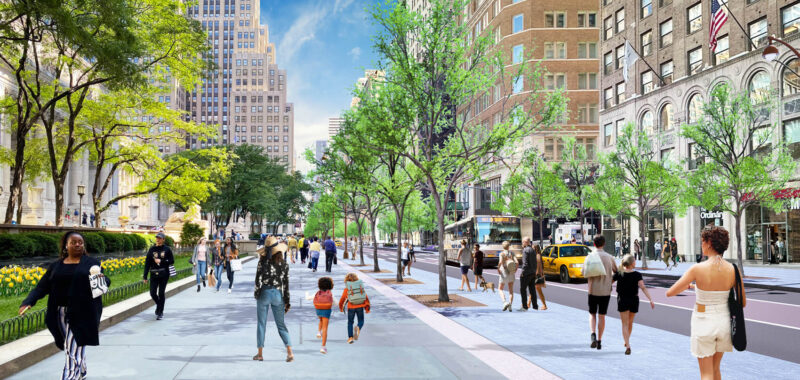A year ago, Field Operations, Sam Schwartz, and Arcadis were tapped to overhaul Manhattan’s Fifth Avenue by the New York City Mayor’s Office. The design team’s mission ever since has been ideating how to pedestrianize slivers of New York’s primary commercial corridor between Bryant Park and Central Park in order to boost foot traffic, and help businesses recover from COVID.
Renderings shared this week by City Hall officials shed light on what that redevelopment may look like. The redesign, according to the design team, is inspired by main thoroughfares across the globe, namely, Paris’s Champs Elysees; Calle Serrano in Madrid; Bond, Oxford and Regent Streets in London; and Ginza in Tokyo.
“New Yorkers deserve an iconic boulevard that will rival the rest of the world,” Mayor Eric Adams said in a statement. “Right now, 70 percent of the people on Fifth Avenue are pedestrians,” Adams continued, “but they can only utilize less than half the space. On the holidays, that’s 23,000 people every hour—4,000 more than a packed [Madison Square Garden]—cramming like sardines into constrained sidewalks. That makes no sense—so we’re going to flip the script.”

The distance between Bryant Park and Central Park is almost one mile. The width between buildings along that stretch is 100 feet. The sidewalks on both sides are 23 feet wide, with five lanes of traffic in between. Signage, bus stops, lighting, trash cans, and overcrowding clutters much of the journey along Fifth Avenue, souring the experience for New Yorkers and tourists alike.
Under the current plan, led by the Future of Fifth Avenue Partnership, sidewalks in the area would be bumped out from 23 to 33.5 feet, marking a 46 percent increase in pedestrian area. Sidewalks would go from 23 to 25 feet, and an additional 8.5 feet would be given over to trees, planting, and street lights. Traffic lanes would be reduced from five to three, with the middle lane serving as a dedicated bus lane.


This lane reduction, from five to three, would cut the length pedestrians have to walk in order to laterally traverse Fifth Avenue by one-third of its current distance, helping decrease traffic-related injuries and deaths.
All in all, the Future of Fifth Avenue Partnership will bring 230 new trees to the area, and 20,000 square feet of new plantings. The project marks Fifth Avenue’s first redesign in its 200 year history. In Manhattan, another well-trafficked street, Park Avenue, is also slated for a redesign aimed at improving walkability.
New York City Hall officials noted that, upon completion, the Fifth Avenue refurbishment will essentially pay for itself in less than five years via increased property and sales tax revenue.

